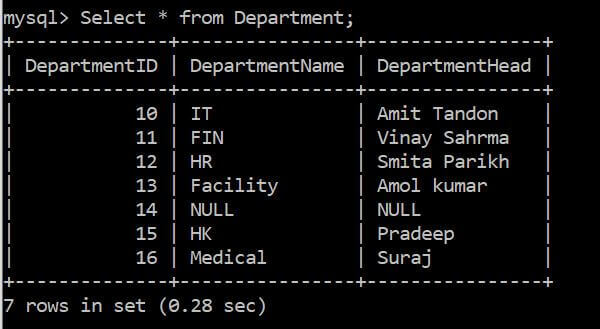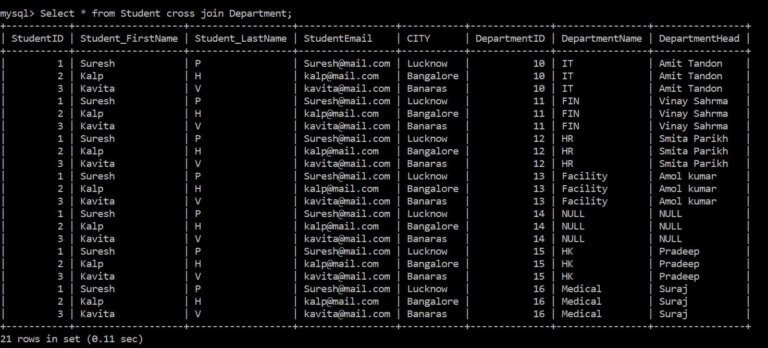SQL Testing
Introduction To RDMS
DataBase
DBMS Vs RDBMS
SQL Tutorials
SQL DataTypes
SQL Operators
SQL Statements
DDL (Data Definition Language)
SQL-Create Table
SQL-Alter Table
SQL-Drop Table
SQL-Truncate Table
DML (Data Manipulation Language)
SQL-Select Statement
SQL-Insert Statement
SQL-Update Statement
SQL-Delete Statement
SQL Constraints
SQL-Not Null Constraint
SQL-Unique Constraint
SQL-Primary Key Constraint
SQL-Foreign Key Constraint
SQL-Check Constraint
SQL Special Operators
SQL-IN Operator
SQL-LIKE Operator
SQL-BETWEEN Operator
SQL Sorting (Order By)
SQL Group By
SQL Aggregate Function
SQL Having
SQL Joins
SQL-Cross Join
SQL-Inner Join
SQL-Left Outer Join
SQL-RIGHT Outer Join
SQL-Self Join
SQL SubQueries
ISQL-Independent Sub Queries
SQL-Correlated Sub Queries
SQL Views
SQL Index
DataBase
DBMS Vs RDBMS
SQL Tutorials
SQL DataTypes
SQL Operators
SQL Statements
DDL (Data Definition Language)
SQL-Create Table
SQL-Alter Table
SQL-Drop Table
SQL-Truncate Table
DML (Data Manipulation Language)
SQL-Select Statement
SQL-Insert Statement
SQL-Update Statement
SQL-Delete Statement
SQL Constraints
SQL-Not Null Constraint
SQL-Unique Constraint
SQL-Primary Key Constraint
SQL-Foreign Key Constraint
SQL-Check Constraint
SQL Special Operators
SQL-IN Operator
SQL-LIKE Operator
SQL-BETWEEN Operator
SQL Sorting (Order By)
SQL Group By
SQL Aggregate Function
SQL Having
SQL Joins
SQL-Cross Join
SQL-Inner Join
SQL-Left Outer Join
SQL-RIGHT Outer Join
SQL-Self Join
SQL SubQueries
ISQL-Independent Sub Queries
SQL-Correlated Sub Queries
SQL Views
SQL Index
What is SQL- CARTESIAN or Cross JOIN ?
- The cross join returns a Cartesian product of rows from both tables.
- It Returns All rows from first table, Each row from the first table is combined with all rows from the second table
If Table 1 Contains n rows and Table 2 contains m rows
Then cross join of both the tables will return m*n rows.
Syntax:
SELECT select_List FROM Table1 cross join Table2;
Example:
Table 1 – Department
Consider Department table having below records.

Table 2 – Student
Consider Student table having below records.

Select * from Student cross join Department
After executing above query , we will find the below result:

Recommended Articles:
SQL Testing
Introduction To RDMS
DataBase
DBMS Vs RDBMS
SQL Tutorials
SQL DataTypes
SQL Operators
SQL Statements
DDL (Data Definition Language)
SQL-Create Table
SQL-Alter Table
SQL-Drop Table
SQL-Truncate Table
DML (Data Manipulation Language)
SQL-Select Statement
SQL-Insert Statement
SQL-Update Statement
SQL-Delete Statement
SQL Constraints
SQL-Not Null Constraint
SQL-Unique Constraint
SQL-Primary Key Constraint
SQL-Foreign Key Constraint
SQL-Check Constraint
SQL Special Operators
SQL-IN Operator
SQL-LIKE Operator
SQL-BETWEEN Operator
SQL Sorting (Order By)
SQL Group By
SQL Aggregate Function
SQL Having
SQL Joins
SQL-Cross Join
SQL-Inner Join
SQL-Left Outer Join
SQL-RIGHT Outer Join
SQL-Self Join
SQL SubQueries
ISQL-Independent Sub Queries
SQL-Correlated Sub Queries
SQL Views
SQL Index
DataBase
DBMS Vs RDBMS
SQL Tutorials
SQL DataTypes
SQL Operators
SQL Statements
DDL (Data Definition Language)
SQL-Create Table
SQL-Alter Table
SQL-Drop Table
SQL-Truncate Table
DML (Data Manipulation Language)
SQL-Select Statement
SQL-Insert Statement
SQL-Update Statement
SQL-Delete Statement
SQL Constraints
SQL-Not Null Constraint
SQL-Unique Constraint
SQL-Primary Key Constraint
SQL-Foreign Key Constraint
SQL-Check Constraint
SQL Special Operators
SQL-IN Operator
SQL-LIKE Operator
SQL-BETWEEN Operator
SQL Sorting (Order By)
SQL Group By
SQL Aggregate Function
SQL Having
SQL Joins
SQL-Cross Join
SQL-Inner Join
SQL-Left Outer Join
SQL-RIGHT Outer Join
SQL-Self Join
SQL SubQueries
ISQL-Independent Sub Queries
SQL-Correlated Sub Queries
SQL Views
SQL Index
